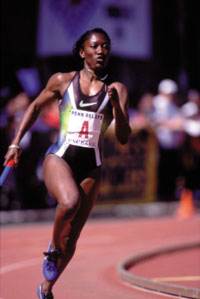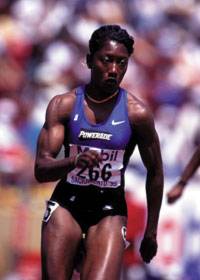SHE'S STILL GOING EVEN AFTER THE GOLDIf one gold medal is good, Chryste Gaines surmises that two gold medals must be even better.By Laura Dayton Published: Spring 1998 Plyometric drills and pulling a sled around the track are tough work. That's why Chryste Gaines likes them. And that attitude is why she has an Olympic gold medal sitting on her shelf, next to her four-year pre-med degree from Stanford University. Sometimes, it's hard to tell which she is more proud of. "I've always been athletic," says Chryste from her Northern California home. "I've been running since junior high school. I was good in other sports, but concentrated on track because of the scholarship opportunities. My parents always told me, ‘You can't run track your whole life, you have to have something to fall back on,' so for me, getting a college education was never a question of do it or not, it was just a question of where I would go." Chryste was raised in southern Dallas and attended South Oak Cliff High School, a predominantly black school. "I guess no one thinks twice about a black female athlete anymore, but a lot of people doubted that I was going to go to Stanford, and graduate! I like it when people doubt me, though—it makes me try harder." Chryste graduated in 1992 with a degree in psychology and a pre-med curriculum under her belt. Not only did she graduate from Stanford with grade points to spare, but she also etched her name into that school's hallowed books of sports fame as a three-time Pacific Ten Conference Champion in the 100 meters and three-time All American. She won the 1992 NCAA Championship indoors in the 55 meters and outdoors in the 100m. That year she also went on to become a member of the 1992 U.S. Olympic Team as an alternate on the 4 X 100 meter relay. After graduation, with her athletic career just beginning to blossom, Chryste decided to put the books away to set her sights on the Atlanta Games and the next couple of seasons. For a time, Chryste remained in California working with her college coach Brooks Johnson. In 1994 she moved back home to train in Dallas with Clyde Hart and was also a volunteer women's track coach at Baylor University in Waco, Texas. A short while later, she returned to California. "I missed my family," she said about the move back. "We're all very close and they've been such great role models for me. My mom is a teacher, my dad is a lawyer and my sister is the one who got me started in track. But when I looked at the opportunities available to me, California had more to offer." The opportunity Chryste is talking about was the chance to work with her current coach, Remi Korchemi. As it turned out, that was an opportunity that turned to pure gold. Remi specializes in the sprints and in bringing home medals. Under his tutelage, Chryste was ranked tenth in the world in the 100m in 1995 after running it in 11.02 seconds and winning the Pan American Games in Argentina. She also won a gold medal at the World Championships in Gothenburg, Sweden, in the 4 x 100m. In 1996 she progressed even more by running a 10.96 in the 100m, placing fifth at the U.S. Olympic Trials and earning a place on the Olympic Team. In Atlanta, Chryste saw another dream come true when she won the gold as the lead-off leg of the 4 x 100m. "It was great, winning the gold, don't get me wrong," says Chryste. "I knew we'd won, and it was fun working with the team. But we'd come there to set a new record, and in that sense it was disappointing. I know a lot of people would think, ‘Hey, you won an Olympic gold medal. What more could you want?' All I have to say to them is, well, two would be nice!" A Busy Year To that end Chryste has stayed busy. In 1998, she earned a spot on the World Championship team in the 100m and the 4 x 100m. She was a finalist in the 100m and won a gold medal in the 4 x 100m while setting a new American record. Now, Chryste's concentrating on the 100m at the U.S. Outdoor Championships later this year. "I doubt anybody has picked me to win," she laughs, "but I feel stronger this year and really think this will be it. And like I said, I like it when they doubt me. I like to defy the odds." Helping those odds this year is the fact that she has completely recovered from a hamstring injury that hampered her performance at last year's Nationals. Working with a chiropractor in Orinda, California, Dr. Michael Ripley, who uses a special treatment to enhance performance called Active Release Techniques soft-tissue management, Chryste feels that the injury is behind her. "The only time I notice it now is when it gets cold; it still kind of aches." Her training in the weight room consists primarily of bench presses, lat pulldowns, squats, cleans and leg curls. She lifts four days a week and squats heavy, but uses moderate weights on her other lifts. Chryste is 5-foot-7 and weighs 134 pounds. As with her weight training, Chryste performs plyos four times a week. She also does box jumps in the gym, hurdle hops, and standing long and triple jumps on the track, in addition to her sled work. She says that she never gets tired of training; still, she knows that a good athlete needs more than just the gym."I look around and see a lot of people today who are choosing not to finish school. Most of them would rather work and earn money than get an education. In my family education was valued, but in other families how soon you can earn money is more important. But if you put it in perspective, education is a vehicle. In sports, it's a way to get a free ride. If you can be an athlete who can make the grades, then you're more of an asset. Kids who just concentrate on sports don't understand that schools also look at whether you're going to be able to stay eligible all those years." She has not forgotten her own academic pursuits, and says that her parents won't let her forget them either. "Remember, my mom's a teacher!" While med school had been a high priority when she entered Stanford, she's now thinking the Ph.D. program and a career in psychology may be more to her liking. Chryste has been very active as a motivational speaker to junior and high school students, and she feels much more work needs to be done to motivate kids today. "Opportunities are out there if you try to do well in school and excel in your athletic endeavors, but a lot of kids don't know this," she says."Collegiate sports for women are only now really being recognized. I'm excited for the young women who are in high school because things are changing so fast for women in sports. Just look at what Atlanta did for women's baseball. And, now we have women's hockey." Chryste hopes that the public will give more recognition to women track athletes in the years to come, and not just during the Olympics. "We get recognition, but I think we deserve a lot more. People are just now getting used to the idea of women as real athletes. Another thing they have to remember is that women athletes are usually around for a long time!" she says, referring to the statistical evidence that women track athletes don't reach their peak until age 28 and the empirical evidence that women distance runners compete well into their 30s and 40s. "Next year should be my peak," says Chryste, who is 27. "I'm not saying that I want to compete forever, but the next Olympics are right around the corner. Could you resist the opportunity?" |
 |
|
Gold Medalist Chryste Gaines |
 |
|
“Not only did she graduate from Stanford, but she also etched her name as a three-time Pacific Ten Conference Champion in the 100 meters and three-time All American.” |